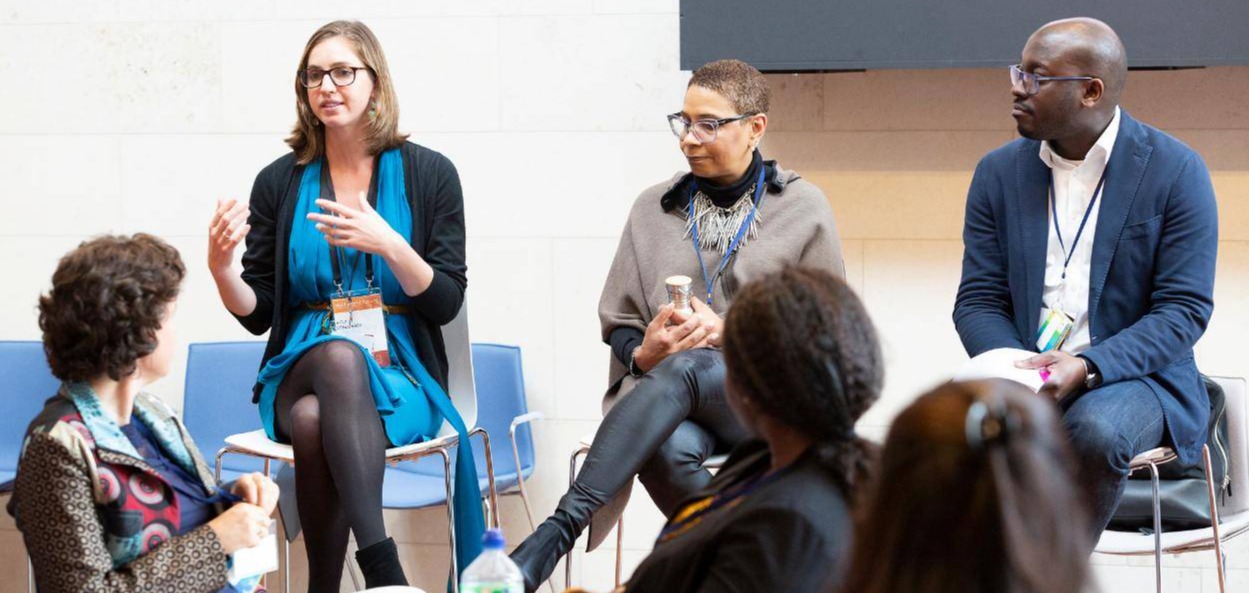Master Innovation
Lean startup principles for the social sector: A look inside Acumen Academy’s course
Find out what a lean startup is and how to apply lean startup principles to the social sector with Acumen Academy's free online lean startup course.
July 24, 2018
Have you ever wondered if there were validated ways to develop a social enterprise idea that you weren’t yet taking advantage of yet?
There is no magic bullet. However, leading thinkers like Steve Blank, professor and Silicon Valley entrepreneur, Eric Ries, author of the Lean Startup, and Alex Osterwalder, creator of the Business Model Canvas, have been refining actionable frameworks to help entrepreneurs grow ventures that deliver on the goals they set out to achieve, often with less resources and in less time than you would initially expect.
The Lean Startup method teaches you how to drive a startup—how to steer, when to turn, and when to persevere—and grow a business with maximum acceleration. —Eric Ries
Over 15,000 people from all around the world, from Argentina to Croatia to Malaysia, have taken the Lean Startup Principles for the Social Sector course to refine new social enterprise ideas or to explore new programs within existing organizations.
There's no shortage of diversity amongst past participants. They are:
- Nurse practitioners working on ways to pick up where health care fails,
- CEOs launching new projects for multi-stakeholder dialogue on resilient rural livelihoods,
- Commercial farmers improving crop production,
- Nonprofit volunteers seeking tools to be more effective,
- Engineers looking to learn about other fields,
- Nonprofit foundations wanting to apply lean methodologies to their work,
- Cafe owners looking for ways to take ideas and turn them into reality,
- And many more.
About the course
As a participant, over five weeks you will work together in teams learning to apply innovation methods from Silicon Valley to the social sector.
First, you’ll learn to understand exactly what the “Lean Startup” approach is. This will include learning how to craft your value proposition by outlining your customers' pains, gains, and jobs to be done using the Value Proposition Canvas. You’ll also learn how to conduct interviews with customers so that you are armed with new information to better meet their needs and create lasting impact. Finally, you’ll learn to design and run experiments to further validate your value proposition.
Past participants have found that they can save considerable time and effort when using a lean approach to develop new businesses or new offers. Many course takers have been surprised after speaking with potential customers when they realize that some of their core assumptions are in fact untrue. Gaining knowledge like this early on in the process can be the difference between years spent building out a faulty or mediocre solution and designing a solution that is highly desirable and valuable.
For example, a group working to create textile and fashion job opportunities for refugees in Brazil shared their learning about how crucial it was to have a clear vision of the problem they wanted to solve before thinking about solutions. By getting out of the building to speak with potential customers, this team learned more about their potential customers’ shopping habits, including specifics like which features of clothing goods should be improved and what type of clothes they look for.
Now let’s dive into a sneak peek of what you can expect to gain from each of the course modules.
Week 1: What are Lean Startup Principles?
Around the time when Jacqueline Novogratz founded Acumen, one of her mentors gave her a piece of advice that still guides our today. The mentor said:
Just start. Don’t wait for perfection. Just start and let the work teach you. No one expects you to get it right in the very beginning, and you’ll learn more from your mistakes than you will from your early successes anyway. So stop worrying so much and just look at your best bets and go.
These sentiments explain in part why Acumen supports a lean approach to social enterprise development. The course starts off with an examination of what Lean Principles are and how they can be adapted from the tech sector and applied to the social sector.
As a participant, this week you learn what it means to adopt a Lean mindset in your impact work and how it can help you avoid wasted time and effort. We explain how to use the Lean ‘Build-Measure-Learn loop’ to guide the process and what it means to 'go lean' in the social sector.
You finish week one by developing your own value proposition using the Value Proposition Canvas. You’ll also identify the assumptions inherent in your current plan, and draft a set of hypotheses to further explore later in the course.
Week 1 in action
One team took the course to further develop their idea of providing farming communities in Liberia with opportunities to farm all year round. The challenge these farmers face is that during the dry season (also called the hunger season) they do not have access to water for their fields and often have to take on other work to sustain themselves and their families each year.
At the end of week one, the team hypothesized that providing a solar water pump and irrigation system to farming communities would alleviate low production in the dry season. Next steps were to gather the information needed to prove this hypothesis true or untrue through customer discovery.
Week 2: Customer Discovery
There are no facts inside your building. So your job is to get outside and test them personally in physical channels by talking to hundreds of customers. – Steve Blank
Throughout this week, course participants begin speaking with real customers "outside of the building" to gather essential insights and start to validate hypotheses outlined the prior week.
After learning about the four stages of customer development, participants are guided through the process of designing an interview template and using it as a guide for speaking with at least one potential target customer.
Week 2 in action
One team member working on a hiring platform fostering more inclusion and innovation in the tech industry found it challenging to determine how to measure success before testing the hypothesis, but appreciated learning how to identify and prioritize assumptions. She looked forward to continuing to use prototypes developed in the course to test and validate the core assumptions.
Another participant was working on a social media platform for teens that aims to support the social and cognitive development and reduce isolation by encouraging more real-life encounters. She found an unexpected split within the teenager customer segment, finding that older teens are more aware of safety and privacy, contrary to initial assumptions, and younger ones are not. She was surprised to learn that not all initial assumptions could be validated but appreciated these insights for informing next steps in the development of the platform.
The team working on solar irrigation in Liberia formulated 19 interview questions to discuss with farmers. Some of the specific hypotheses they were seeking clarity on were related to understanding if water pumps would indeed contribute to farming year round, whether families would be willing to purchase the product together as a group, and the willingness and ability to use new technology.
Week 3: Designing minimum viable products and Lean Experiments
One of the biggest failures of our sector is that we don’t think about learning quickly. We spend a lot of time building something that we think is perfect without ever letting that product interact with customers. – Sasha Dichter, Acumen’s former Chief Innovation Officer
Throughout this week, course takers gain clarity on what a 'minimum viable product' (MVP) is and how to design one that can be used in the Lean process to gather insights and data to support or reject the core hypotheses laid out in earlier in the course. We address the differences between MVP's and pilot programs and cover how to conduct experiments that are ethical and considerate of potential customers.
As a participant, you are challenged to design your first, or next, MVP and a simple but effective experiment or test you can run to gather information. MVP’s can take on a range of quality, but at the beginning should be simple and quick to put together. The first MVP could be offering a trial of the new product, running an advertisement to collect information from those interested in the offer, or using a simple mockup or diagram to explain how a more complex product would be used. In-person interviews are another simple way to validate ideas and gain real insights from potential customers.
Week 3 in action
The group discussing solar irrigation with farmers in Liberia chose to use a basic drawing to help explain how the system would work and learn more about how the farmers go about their work. One significant discovery from this initial discussion was that farmers were very interested in using solar energy for their everyday household activities, not just for field irrigation.
Week 4: To pivot or persevere
The quicker you can put aside your ego and pay attention to these early signals about whether your value proposition is really working, the faster you can build something your customers really want. Staying Lean requires discipline & humility.
This module looks at the ‘learn’ section of the Build-Measure-Learn Lean Loop. Participants practice strategies for capturing learning in order to synthesize findings and distinguish between opportunities to pivot, persevere and iterate.
As final deliverables, the course concludes with an update to the Value Proposition Canvas for the impact initiative your team has been refining, so it is ready to begin the next cycle of Lean learning and continuous improvement.
Week 4 in action
In a past cohort, a team from India was developing a coffee product that made use of excess crops from existing production and commanded higher prices with the additional value of roasting and packaging. After completing the course, they reflected that understanding the choice to pivot opened up new possibilities. Instead of giving up when an initiative hits obstacles, pivoting a product or business model opens up opportunities to keep going until you achieve product-market fit.
The solar irrigation project in Liberia also arrived at new learnings that meaningfully shifted their direction. As a result of conducting customer interviews, the team adapted their target customer and uncovered new features their technology could offer that were important to customers, such as light, electricity and running water. They also learned the collective payment plan they had envisioned might be difficult to implement given the proximity and relationships between neighboring farms.
Notes about the course format
We recommend students join in teams of 2 to 8 in order to have the richest course experience. We strongly recommend that course participants find a group of coworkers or friends that they can take the course with in person. You can also connect with others in your local area by posting on the course discussion forums which open one month before the course starts.
Over the five weeks, individuals are free to go through the module readings, videos and real-life case studies at their own pace (roughly 1-2 hours per week). Then, you’ll meet with your team to go through the workbook exercises (expecting another two hours per week to workshop group exercises and assignments).
Course participants who submit 3 of the 4 assignments (including the final summary deck) plus the team formation assignment, will earn a Statement of Accomplishment for taking part.
Try it out for yourself!
Whether you share passions with past participants working on causes like gender equality, economic empowerment, sustainable technology in rural areas, or healthy active living for older adults - or bring your own - this course provides the tools to quickly integrate the true needs of your customers into your offerings and build stronger social enterprises.
Sign up for the next cohort of Acumen Academy's Lean Startup Principles for Social Impact course today!

Author
Danielle Sutton
Danielle Sutton is the Content Animator at Acumen where she surfaces stories to inspire and activate social entrepreneurs. In an age of information overload, she believes in learning 'the right thing at the right time' to intentionally design impactful social enterprises. You can usually find Danielle digging into the Acumen course library, playing in the mountains, or exploring marketing on The Sedge blog.


